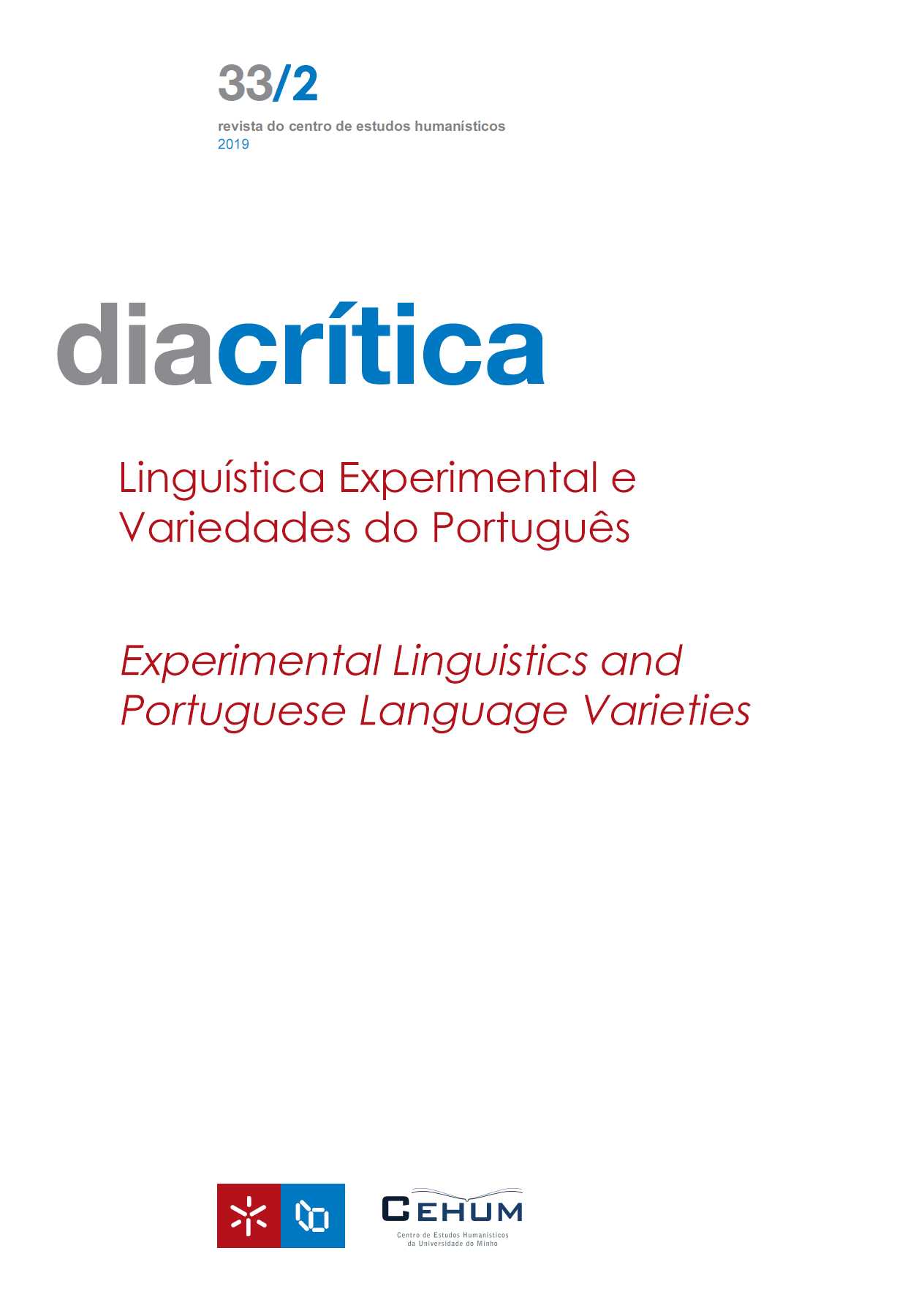The bare singular in english and brazilian portuguese experimental approaches on atomicity
DOI:
https://doi.org/10.21814/diacritica.5059Keywords:
Comparison, Mass-count distinction, Brazilian Portuguese, Bare SingularAbstract
From the grammatical notion of atomicity, we propose an analysis for the Bare Singular (BS) both in English and Brazilian Portuguese (BrP). Our aim isto verify experimentally the atomic property (or not) of these noun phrases. To do so, we analyse data from a test performed by Scontras et al. (2017), which show that the BS in English mainly raises volume reading in comparatives. According to our analysis, this interpretation is explained as coercion, which corroborates the denotation of the SNU as an atomic predicate in this language. For the case of the BS in BrP, we developed a quantity judgment test, relying on Scontras et al. (2017) methodology, to verify the dimensions of comparison used with the plural, mass and BS nouns, opposed to sentences without the name in the prompt (Who has more?). The results show that sentences with the BS raise the same judgments as the ones without the noun in the prompt. We argue, then, that the BS in BrP does not carry any grammatical feature for atomicity, unlike the plural and the mass nouns, which carry [+ atom] and [-atom] features respectively.
References
Bale, A.& D. Barner. (2009). The interpretation of functional heads: Using comparatives to explore the mass/count distinction. JournalofSemantics,26,217–252.https://doi.org/ 10.31234/osf.io/ktx59. DOI: https://doi.org/10.1093/jos/ffp003
Barner, D.&Snedeker, J. (2005). Quantity judgments and individuation: Evidence that mass nouns count. Cognition,97(1), 41–66.https://doi.org/10.1016/j.cognition.2004.06.009. DOI: https://doi.org/10.1016/j.cognition.2004.06.009
Beviláqua, K. &Pires de Oliveira, R. (2014). Brazilian bare nouns and referentiality: Evidence from an experiment. RevistaLetras, 90, 235–275. https://doi.org/h10.5380/rel.v90i2.37234. DOI: https://doi.org/10.5380/rel.v90i2.37234
Beviláqua, K.&Pires de Oliveira, R. (2017).Brazilian bare nouns in comparatives: Experimental evidence for non-contextual dependency. RevistaLetras, 96, 354–376.https://doi.org/10.5380/rel.v96i1.51033. DOI: https://doi.org/10.5380/rel.v96i1.51033
Beviláqua, K.&Pires de Oliveira, R. (2018). What do bare nouns mean cross-linguistically? Preliminary results. Artigo apresentado emThe Mass-Count distinction -A linguistic misunderstanding?, 7–9 maio, Bochum, Alemanha. Resumo disponível em http://count-and-mass.org/becl2018/abstracts/AbstractBochumBevilaquaandPiresdeoliveira.pdf
Beviláqua, K., Lima, S. &Pires de Oliveira, R. (2016).Bare nouns in Brazilian Portuguese: An experimental study on grinding. Baltic International Yearbook of Cognition, Logic and Communication, 11, 1–25. https://doi.org/10.4148/1944-3676.1113. DOI: https://doi.org/10.4148/1944-3676.1113
Bloomfield, L. (1933). Language. New York: Henry Holt.
Chierchia, G. (1998). Plurality of mass nouns and the notion of semantic parameter. In S. Rothstein (Ed.), Eventsandgrammar(pp. 53–103). Dordrecht: Kluwer. DOI: https://doi.org/10.1007/978-94-011-3969-4_4
Chierchia, G. (2010). Mass nouns, vagueness, and semantic variation. Synthese, 174, 99–149.https://doi.org/10.1007/s11229-009-9686-6 DOI: https://doi.org/10.1007/s11229-009-9686-6
Chierchia, G. (2014). How universal is the mass/count distinction? Three grammars of counting. In A.Li, A.Simpson &Wei-Tien Dylan Tsai(Eds.), Chinesesyntaxina cross-linguistic perspective (pp. 147–175).https://doi.org/10.1093/acprof:oso/9780199945658.003.0006 DOI: https://doi.org/10.1093/acprof:oso/9780199945658.003.0006
Cresswell, M. J. (1976). The semantics of degree. InB. Partee(Ed.), Montaguegrammar(pp. 261–292). New York: Academic Press. DOI: https://doi.org/10.1016/B978-0-12-545850-4.50015-7
Doetjes J.S. (2017).The count/mass distinction in grammar and cognition. AnnualReviewofLinguistics,3,199–217.https://doi.org/10.1146/annurev-linguistics-011516-034244 DOI: https://doi.org/10.1146/annurev-linguistics-011516-034244
Frisson, S.&Frazier, L. (2005). Carving up word meaning: Portioning and grinding. JournalofMemoryandLanguage, 53(2),277–291.http://doi.org/10.1016/j.jml.2005.03.004 DOI: https://doi.org/10.1016/j.jml.2005.03.004
Jespersen, O. (1924). The philosophy of grammar. London: George Allen &UnwinLtd.
Krifka, M. (1998). The origins of telicity. In S. Rothstein (Ed.),Eventsandgrammar(pp. 197–235).Dordrecht: Kluwer. DOI: https://doi.org/10.1007/978-94-011-3969-4_9
Lima, S. (2014). The grammar of individuation and counting(Tesede doutoramento, University of Massachusetts,Amherst, USA).
Link, G. (1983). The logical analysis of plurals and mass terms: A lattice-theoretical approach. In R. Bauerle, C. Schwarze &A. Stechow(Eds.), Meaning, use, and interpretation of language(pp. 302–323). Berlin: de Gruyter. DOI: https://doi.org/10.1515/9783110852820.302
Menuzzi, S. D. M., Silva, M. C.F.&Doetjes, J. (2015). Subject bare singulars in Brazilian Portuguese and information structure. JournalofPortugueseLinguistics, 14(1), 7–44. https://doi.org/10.5334/jpl.56 DOI: https://doi.org/10.5334/jpl.56
Nakanishi, K. (2007). Measurement in the nominal and verbal domains. LinguisticsandPhilosophy,30,235–276.https://doi.org/10.1007/s10988-007-9016-8 DOI: https://doi.org/10.1007/s10988-007-9016-8
Paraguassu-Martins, N. &Muller, A. (2008). A distinção contável–massivo e a expressão de Nnúmero no sistema nominal. DELTA: Documentação de Estudos em Linguística Teórica e Aplicada, 23,65–83.https://doi.org/10.1590/S0102-44502007000300006 DOI: https://doi.org/10.1590/S0102-44502007000300006
Pelletier, F.J. (1979). Non-singular reference: Some preliminaries. In F.J. Pelletier (Ed.), MassTerms(pp. 1–14).Dordrecht: Reidel. DOI: https://doi.org/10.1007/978-1-4020-4110-5_1
Pelletier, F. J. (2012). Lexical nouns are both +MASS and +COUNT, but they are neither +MASS nor +COUNT.In D.Massam(Ed.),Count and Mass Across Languages(pp. 9–26).Oxford: Oxford Scholarship.https://doi.org/10.1093/acprof:oso/9780199654277.003.0002 DOI: https://doi.org/10.1093/acprof:oso/9780199654277.003.0002
Rothstein, S. (2010). Counting and the mass/count distinction. JournalofSemantics, 27(3), 343–397.https://doi.org/10.1093/jos/ffq007 DOI: https://doi.org/10.1093/jos/ffq007
Rothstein, S. (2017). Semantics for counting and measuring. Cambridge: Cambridge University Press. DOI: https://doi.org/10.1017/9780511734830
Santana, R. &Grolla, E. (2018). A aceitabilidade do singular nu pré-verbal em Português Brasileiro. Linguística,14(2), 194–214.https://doi.org/0.31513/linguistica.2018.v14n2a17532 DOI: https://doi.org/10.31513/linguistica.2018.v14n2a17532
Schwarzschild, R. (2006). The role of dimensions in the syntax of noun phrases. Syntax,9(1),67–110.https://doi.org/10.1111/j.1467-9612.2006.00083.x DOI: https://doi.org/10.1111/j.1467-9612.2006.00083.x
Scontras, G., Davidson, K., Deal, A.R. &Murray, S.E. (2017). Who has more? The influence of linguistic form on quantity judgments. Proceedings of Linguistics Society of America 2, 41, 1–15.https://doi.org/10.3765/plsa.v2i0.4097 DOI: https://doi.org/10.3765/plsa.v2i0.4097
Soja, N. N., Carey, S.&Spelke, E. (1991). Ontological categories guide young children’s inductions of word meaning: Object terms and substance terms. Cognition,38(2),179–211. https://doi.org/10.1016/0010-0277(91)90051-5 DOI: https://doi.org/10.1016/0010-0277(91)90051-5
Wellwood, A. (2015). On the semantics of comparison across categories. LinguistandPhilosophy,38(1), 67–101. https://doi.org/10.1007/s10988-015-9165-0 DOI: https://doi.org/10.1007/s10988-015-9165-0
Downloads
Published
How to Cite
Issue
Section
License
Copyright (c) 2023 Kayron Beviláqua, Roberta Pires de Oliveira

This work is licensed under a Creative Commons Attribution-NonCommercial 4.0 International License.










